8 Fast Takeaways from Google Marketing Live 2024
Similar to last year, Google Marketing Live provided a torrent of AI-fueled advances for advertisers. In all, nine presenters announced 30 products and features over the 90-minute keynote event.
In the upcoming days and weeks, we’ll examine each of these new products and features in-depth and share what marketers and advertising experts think of them as they roll out.
But for now, here’s a quick recap of the most important announcements from Google Marketing Live 2024, plus some early reactions from experienced PPC marketers.
Contents
- Automatic ad placements in AI overviews
- AI-powered, personalized recommendations and advice
- AI creative asset production for PMax campaigns
- AI-enhanced Shopping Ads
- New visually immersive ad formats and features
- Cohesive first-party data management
- Visual brand profiles on search
- New profit optimization goals on PMax
- What we didn’t see at Google Marketing Live 2024
- What it all means
8 biggest takeaways from Google Marketing Live 2024
The GML keynote was a fast and furious hour and a half. Here are the biggest announcements from the event.
1. Automatic ad placements in AI overviews
Just last week at Google I/O, Google announced the wider release of AI overviews in search results (formerly known as SGE or Search Generative Experience). Now, Google is testing automatically placed Search, PMax, and Shopping Ads in AI Overview boxes.
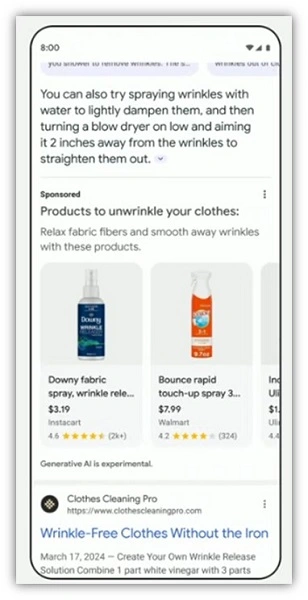
The ads will show up in a block labeled “Sponsored” to separate them from the organic and AI-derived content.
Google will place these ads automatically when they match the intent of both the query and the AI Overview; advertisers don’t need to take any action to target those placements.
Greg Finn of Cyprus North Marketing expressed the cautious optimism we heard from several marketers about the new Overview Ads. They’re a step in the right direction, but are they tucked too far down the page to generate real traffic? And how will they affect CPCs?
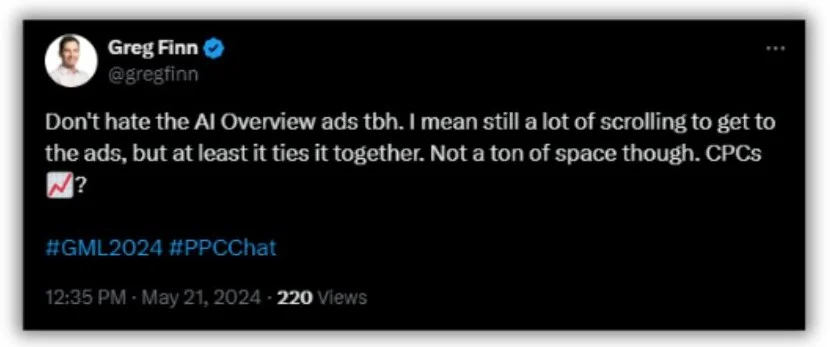
💡 Need to optimize your Google Ads? Our Free Google Ads Grader will show you how.
2. AI-powered, personalized recommendations and advice
In another experiment, Google is using AI to speed along shoppers’ decision-making process for large or complicated purchases by offering personalized product recommendations.
Google used the example of someone shopping for storage space.
The user would search for “short-term storage” and click on a relevant ad. They would then enter a guided shopping experience where they could answer questions and provide a photo of what they wanted to store.
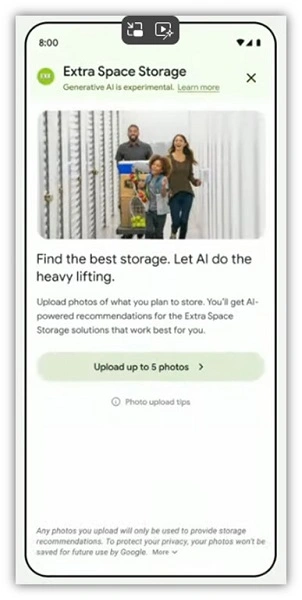
Google’s AI reviews the details and suggests the right-size storage unit and related items like packing materials. The user then clicks through to a product page on the business’s website to finalize their purchase.
This ad feature is currently in the testing phase. If it’s successful, it will soon be available to other verticals.
🔎 Download the Google Ads Benchmarks Report to get a true read of your PPC performance.
3. AI creative asset production for PMax campaigns
Google announced more features and tools to help advertisers create PMax campaign assets faster and at scale. These new features include:
- The ability to add brand guidelines for colors, fonts, and imagery.
- Image editing is used to add and extend backgrounds, add objects, and alter image sizes to fit multiple ad placements (think of adding a plant and expanding the wall for a furniture ad).
- Auto-generation of ads from a product feed.
- Asset-level conversion metrics.
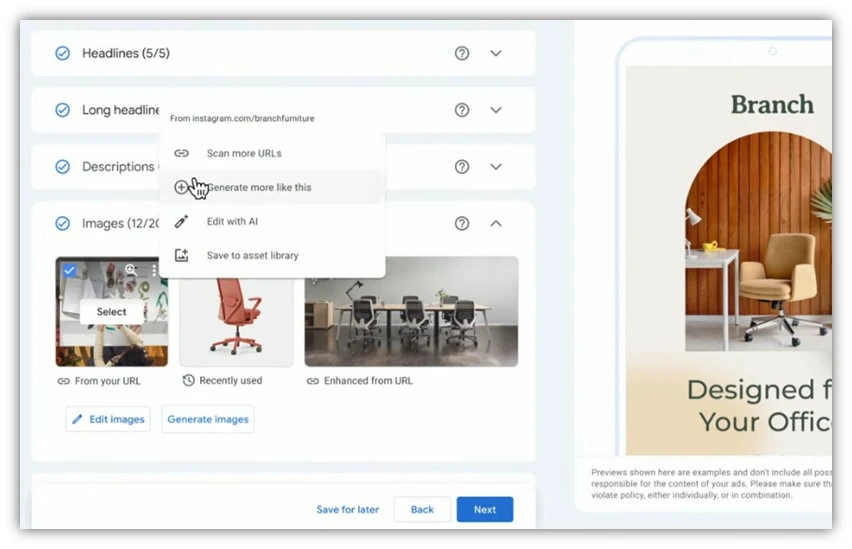
As slick as these ads look, they missed the mark for many marketers like Jon Kagan, whose challenges revolve around the opacity of PMax ads, not producing more creative assets.
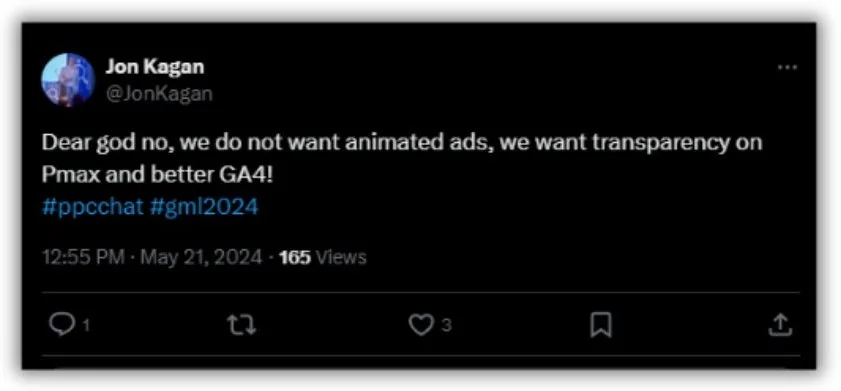
4. AI-enhanced Shopping Ads
Shopping Ads got another layer of AI treatment with several upgrades to create a more immersive shopping experience.
Virtual try-on for apparel
Google is expanding its virtual try-on (VTO) experience to apparel ads. Beginning with men’s and women’s tops, users will be able to see how individual styles look on different body types.
3D product images
Using Adidas brand sneakers as an example, Google showed off new 360-degree shoe views that can be featured in ads. Google generates the 3D views using images provided by the seller.
This may end up being a popular option for the narrow band of PPCers who can use it. It’ll be interesting to see how many holiday ads get this treatment.
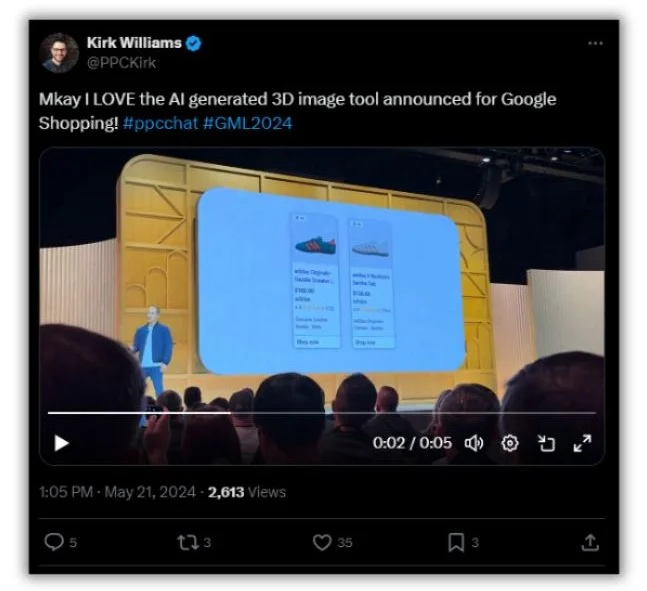
In-ad, short-form product videos
Advertisers can now incorporate short product videos—created by the brand or by influencers—into ads. The videos will be clickable and interactive, letting shoppers view related products and get styling suggestions.
The ads will include product details under each video.
5. New visually immersive ad formats and features
Google shared that it’s expanding its demand-gen video ad campaigns by adding new options for advertisers. These features include:
- Clickable stickers created from existing image assets.
- The ability for users to swipe left to a branded YouTube landing page.
- AI-generated animations based on static images.
These look like potentially neat little features, but how useful will the average PPCer find them? For the most part, these announcements raised more eyebrows than expectations.
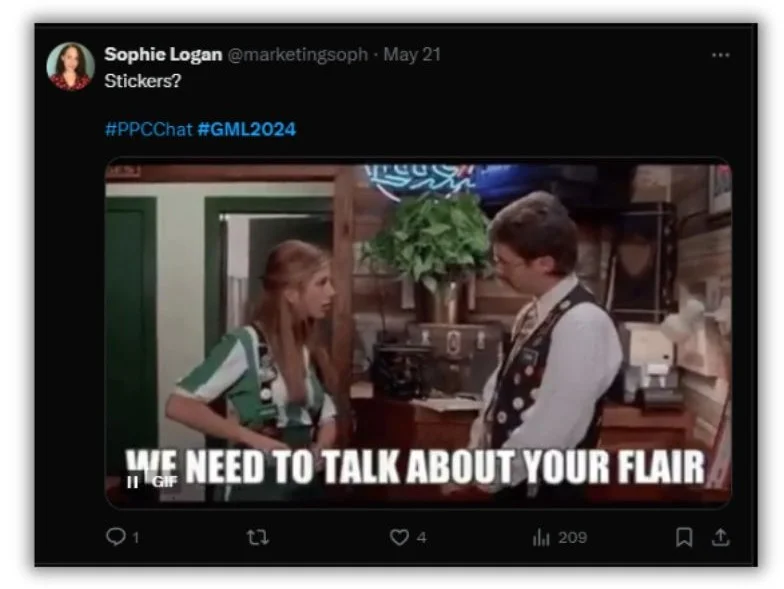
6. Cohesive first-party data management
In a move to improve the quality of data used to guide AI outputs, Google announced that its Ads Data Manager platform is coming out of beta testing and is now widely available.
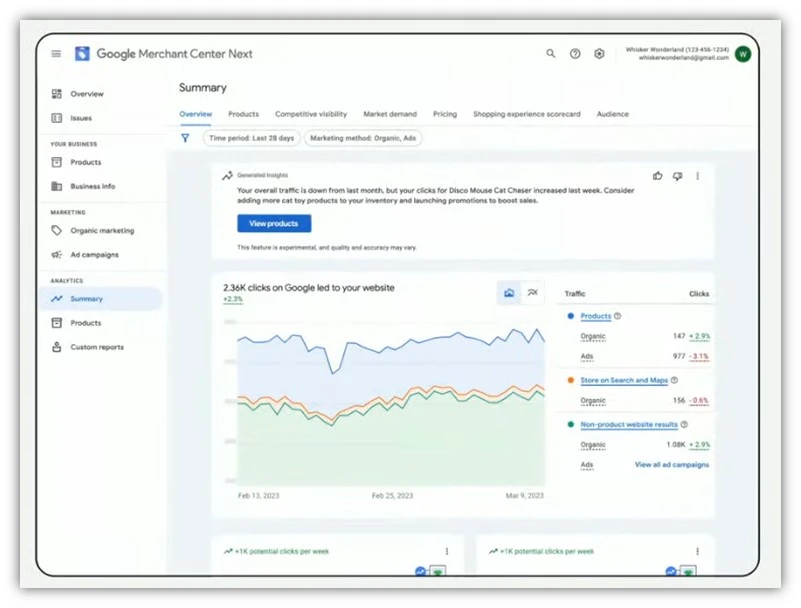
Ads Data Manager lets advertisers aggregate first-party data from sources like YouTube, Google Ads, HubSpot, and Shopify to make it more visible and actionable. The platform also acts as a “check engine light” to help make sure marketers are using data safely and responsibly.
Overall, more data transparency and organization is a good thing. But it didn’t go unnoticed by PPC veterans like Kirk Williams of Zato Marketing that the new platform is another way for Google to gather and control data.
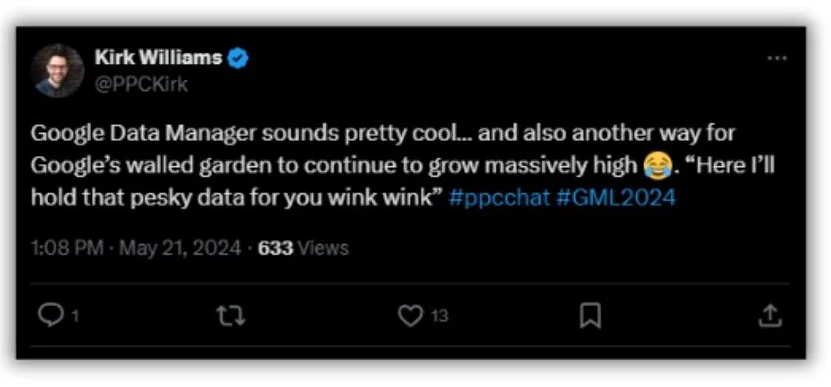
7. Visual brand profiles on search
Sellers can now create a brand profile for Search, including branded imagery, product deals, videos, and more.
Brand profiles will also include reviews pulled from Product Listing Ads. It remains to be seen how much control advertisers have over which reviews are shown.
8. New profit optimization goals in PMax
Advertisers will be able to optimize ads for profit goals in Performance Max campaigns.
Google says advertisers using the new profit goals saw a 15% uplift in campaign profit compared to revenue-only goals.
Google says advertisers using the new profit goals saw a 15% uplift in campaign profit compared to revenue-only goals. That’s great news, but as Boris Beceric, a Google Ads consultant and coach, pointed out, it could open the door to increased ad costs for the most profitable campaigns.
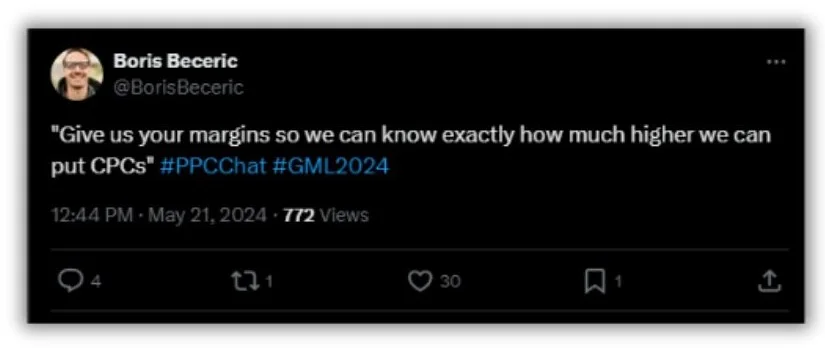
What we didn’t see at Google Marketing Live 2024
There was a lot for advertisers to be excited about in this year’s GML keynote, but a couple of topics stood out by their absence.
No B2B-specific products or features
Once again, the 90-minute Google Marketing Live session focused on the rollout of products designed to help business-to-consumer brands generate more return from their Google Ads investments.
There wasn’t a single mention of a B2B company, example, or use case. For obvious reasons, we’d have loved to see some.
No (or too few) small-business case studies
The vast majority of Google advertisers are small businesses. It didn’t go unnoticed that just about every example, case study, and customer story featured big brands using Google’s newest features to attract new customers.
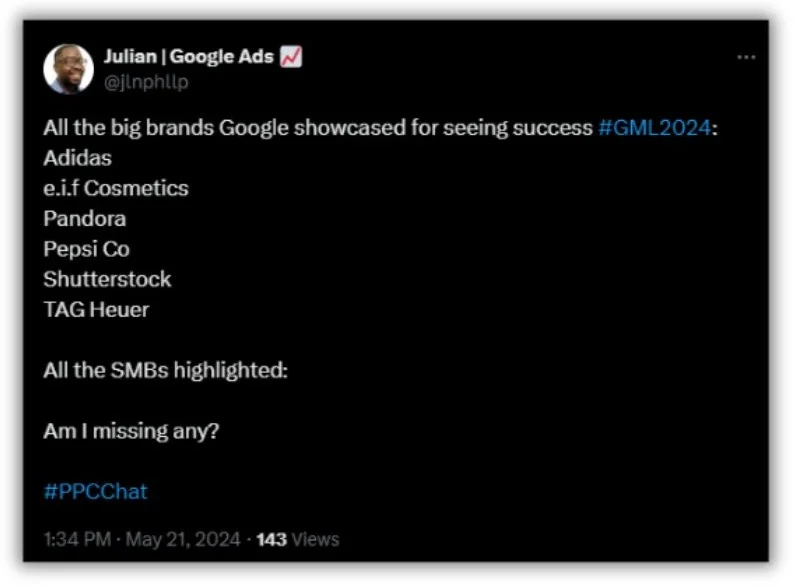
The majority of example use cases for the new features announced at Google Marketing Live 2024 were for travel and ecommerce–industries that typically thrive in the search ads environment. Meanwhile, the typical small business wouldn’t be able to reap the same benefits from these new features.
Our hope is that Google wants to use AI to make advertising easier for smaller businesses with smaller budgets too.
What it all means
Google threw a lot of stuff at us in the 90-minute GML keynote. Some of it looked useful for most marketers’ ultimate goal: to generate more revenue from Google Ads. But a lot of it felt like a spruced-up, AI-coated repeat from years past.
Shiny AI features don’t address the biggest advertiser needs
Google has been moving toward more automation for years. So far, its new AI features look like the same car with a new paint job.
As Julie Bacchini, President of Neptune Moon and Managing Director of PPCChat, tweeted, “So overall, it does not feel like anything really that impactful was announced. A whole lot of AI will be everywhere, but not much else.”
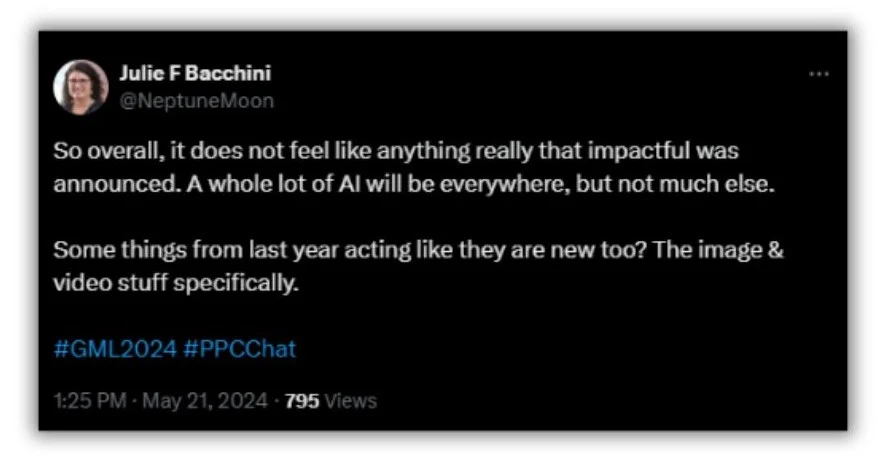
What advertisers really want is more visibility and control over their ads. Which is why we heard the loudest cheers for new PMax controls and reporting. Ideally, Google should focus its AI more on helping advertisers manage ads and understand their performance and less on creative production that’s only useful to large brands in a small number of industries.
The effectiveness of ads in AI Overviews remains to be seen
Marketers are rightfully concerned (see here and here) about the effect AI Overviews will have on their organic search traffic. Google seems to be hoping the new AI Overview ad placements could help alleviate some of those concerns.
However, we saw many questions about Overview Ads from PPC marketers. Are they too far down the page? How will they affect CPCs?
“It’s always a bit concerning to me when Google takes liberties such as these,” Cliff Sizemore, the Sr. Marketing Manager of Growth here at WordStream by LocaliQ, told us. “Just from my experience in search, the queries and intent (close variants in particular) aren’t always in line with the keyword, and I have the same concern about this. I can see how it would be helpful to users to find what they’re looking/shopping for, but AI isn’t perfect, so only time will tell when it comes to the impact on advertisers.”
It’ll also be interesting to see where Google places these ads. Most likely, Google will reduce risk to its primary source of profit by keeping highly commercial SERPs focused on traditional ads, not burying them in AI Overviews, for now.
New ad features may increase clicks but drive up CPLs
It’s possible that all these new AI bells and whistles—360-degree product views, in-ad videos, clickable stickers—will make ads more clickable. But ultimately, a higher click-through rate isn’t great if it doesn’t result in more conversions. Those extra clicks could drive up the cost per lead (CPL), which is the trend we’ve been seeing, as outlined in our most recent search advertising benchmarks report.
We’ll dig deeper into all these announcements and new AI features in an upcoming post, but for now, the takeaway is clear: Google is investing heavily in AI across the board. We get the feeling that not all users are quite as excited about AI as Google is, and regardless, there are bound to be some hiccups, as with any new technology. But we’ll be here to help you all navigate the changes.









Comments
Please read our Comment Policy before commenting.